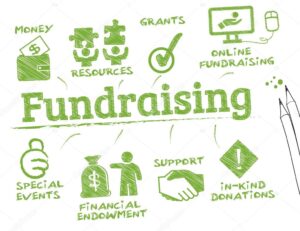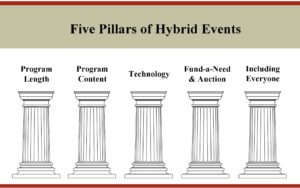Aug 2, 2022 | Uncategorized
We’ve analyzed our first six months of events, identified the top takeaways and strategies, and put it all together in a 30-minute video for YOU. Learn from Glen Fladeboe, Kristin M. Kroll, Erika LaDousa, Stacey McCurnin, Kate Pearce, & Kimberly Proffitt as they share our Top 11 Takeaways of the First 117 Events in 2022.
Click here to watch now!
The full video has ALL of our takeaways but we know your days are busy. See below for the list of segments, with timestamps, so you can jump ahead or reference back.
Overall trends:
- Giving is Strong (2:39)
- There is a Feeling of Importance (3:30)
- Trust is at the Heart of Fundraising (4:00)
- Dollars Up, Donors Down (6:10)
Key Strategies:
- Use Space to Create the Right Feeling (7:50)
- Welcome with Impact (11:00)
- Be Authentic (14:26)
- Have the Fund-A-Need First (for SOME) (17:18)
- Hidden Opportunities in the Live Auction (23:00)
- Keep the Program Brief (25:00)
- Use Your Data (28:13)
Please share with your colleagues and peers and do not hesitate to reach out to our team with questions. This on-demand video is available to access at any time and can be watched as many times as you like. It’s our resource for you!
Dec 10, 2021 | Uncategorized
As we close the books on 168 fundraising events for our team in 2021, what have we learned?
Our team only offers a few webinars each year. We get busy in the focused work of each fundraising season but then take time to reflect, hone our practices and strategies, and share them with our clients, partners, and friends. In short, this is your chance to learn!
We held a webinar on December 9th. Did you miss it? No problem. Watch the recording. (Access Passcode: KBbQ^Tv5)
You’ll hear about the five key considerations for your 2022 fundraising event and the case studies behind them, presented by team members Glen Fladeboe, Kristin Kroll, Stacey McCurnin, Kate Pearce, and Kimberly Proffitt. While addressing virtual, hybrid, and in-person events, our team shared:
- The strength of small(er) in-person events
- Creating and cultivating a strong advocate team
- Using stewardship to ignite and deepen donor relationships
- Using the live auction as a tool for mission-based giving
Watch the recording at: https://us02web.zoom.us/rec/share/g8Wno_o2WK85qYuuJoCJClM1-Df-ytMLpK13T76dBmn470HEQMKdL8SpG7zuQIUO.RbxEWnd5lboe8F5I
Access Passcode: KBbQ^Tv5
We welcome your questions and comments. Please use our contact form or email Kristin@FladeboeAdvancement.com.
Aug 16, 2021 | Uncategorized

Written by Glen Fladeboe
Though it still feels like summer outside, the planning for fall events is in full swing. The first fall event for our team is less than three weeks away! And, of course, the big question on our minds right now is “how will the Delta variant affect fundraising events for the fall of 2021?”
So many things can change in a month, a week, or even a few days. At the time of writing, most of our fall clients are staying with an in-person event, yet some have concerns. We never assert that we have all the “right” answers, but the one thing we are confident about: fundraising events – regardless of the format — can (and will) still be successful this fall. Here are our tips for the how and why.
Many fundraising elements work both in-person and online
The pandemic of 2020 taught us the core set of fundraising best practices for in-person, virtual, and hybrid events is essentially the same:
- Use a campaign model for fundraising
This model focuses less on a single event and more on a period of giving. Efforts are made to raise a significant amount of funds ahead of any “capstone” event, which can then be used to motivate others to reach a final goal.
- Make sure your message is strong and inspiring
Whether spoken live from stage or via video, the message motivates. Boil it down to the key elements and make sure it is delivered in a heartfelt manner.
- Rally “advocates” to encourage attendance (or viewing) and giving
This group is critical for sharing their passion and creating excitement for your mission. Their energy and support builds trust and influences the actions of others.
Supporters believe in your mission
People are ultimately motivated by the mission, not the event itself. They want to see you succeed and continue doing your great work. Don’t be afraid to ask supporters if they will commit to supporting you no matter what the format ends up being. My guess is most people will say, “Yes, absolutely!”
What you should be doing, no matter what
Keep supporters updated about your mission throughout the year. When someone gives of time, talent, or treasure, part of the “reward” of doing so is knowing those efforts made a difference. Thoughtfully updating your supporters on the outcomes of the organization’s work should be done on a consistent basis. Then, as you move into future campaigns/events, supporters know what has been accomplished and are more likely to support you again.
Let our team guide you on options
Though we can’t make the decision on what type of event to hold, we can offer ideas for, and feedback on, the options you are considering. Our job is to help you fundraise, whether in a ballroom or online. Fundraising shouldn’t stop. You can do it! Reach out to learn how we at Fladeboe Advancement can help.
———-
Glen Fladeboe, Principal Partner and Auctioneer, has been the driving force in building Fladeboe Advancement into a premier benefit auction and donor engagement consulting company. With nearly 25 years of experience as a professional auctioneer and fundraiser, he is proud to be part of a second-generation, family-owned business. He holds a degree in communications from Hamline University and lives with his wife, two young daughters, and dog in Minneapolis, Minnesota. He enjoys marathon running, hunting, driving tractor, and spending time at his cabin on the south shore of Lake Superior
Jul 6, 2021 | Uncategorized

Written by: Kimberly Proffitt
Early summer is the season for fundraising reports and surveys. It’s almost like Christmas when some of the national reports come out, full of data about giving in the past year and predictions for the current year. (Well, maybe not for everyone, but definitely for this data geek.) In June our team reviewed three reports, and all of them keep us optimistic about fundraising in 2021:
- Giving USA 2021, one the largest and longest-running studies in the US of giving from individuals (including bequests), corporations, and foundations
- Burk Donor Survey 2021 (pre-release) (BDS) – a survey asking more than 20,000 donors how they gave in the past year and how they expect to give in the coming year
- Fundraising Effectiveness Project Q1 2021 (FEP Q1/21) – a quarterly report providing statistics on donors, dollars, and retention across more than 241 million donation transactions
Why are we optimistic? Consider these select toplines:
- Overall giving grew in 2020 by 3.8% (Giving USA) – donors stepped up in a time of uncertainty
- Giving in 2020 was a record 2.3% of the US gross domestic product (Giving USA) – especially significant given we were in a recession (which normally leads to a fall in giving)
- 56% of donors gave more in 2020 than they did in 2019 (BDS) – the highest percentage reported since 2009 and a 19 percentage-point jump over 2019
- 79% of donors who gave in 2020 plan to give the same or more in 2021 (BDS) – giving in 2020 wasn’t just a “one-time” thing for many donors
- The number of donors grew by 10% in Q1 2021 compared with Q1 2020 (FEP Q1/21)– the highest growth ever seen in the data in a normally lackluster quarter
- Total dollars given are up 6% in Q1 2021 compared with Q1 2020 (FEP Q1/2021) – driven by those giving less than $500
Where should you focus?
Our optimism is tempered by one thing all these reports had in common: the recommendation (dare we say imperative?) to focus on donor retention. The generous outpouring of giving in 2020, from both established and new donors, was a big deal given all the uncertainty of the year. Yet with the overall donor retention rate in the US at 43.6% and the new donor retention rate at 19.3%, there is a lot of turnover among our donors. This, in turn, is not good for long-term organizational sustainability and growth. Now that things are more stable, can we sustain the growth of 2020? We know economic recovery has not impacted everyone (or all nonprofits) equally, with some doing very well and others struggling. The economy has a large influence on giving, and this will continue to be the case throughout 2021.
What’s happening in 2021 so far?
One piece of good news already in 2021: the FEP report for Q1 2021 shows a slight overall increase in retention (compared to Q1 2020). Leading the charge on this increase are donors who were new in 2020 (up 13.6%!) – a traditionally difficult segment to retain! Progress? Yes – and let’s keep it up! We are huge proponents of retention work and have added to our consulting services over the past few years to focus on just that. Ask about what we have been doing!
Watch for upcoming blogs with more detail on each of the reports. You can also access the reports using the following links:
Burk Donor Survey 2021 (releases in July 2021, fee for report)
Fundraising Effectiveness Project Q1 2021 Report (provide email for a free copy)
Giving USA 2021 (infographic free, fee for full report)
———————
Kimberly Proffitt, Research, Analysis, and Donor Engagement Consultant at Fladeboe Advancement, has worked in the nonprofit sector her entire career, focusing on fundraising and philanthropy for the past 22 years. She takes a special interest in helping organizations understand the stories data tell, strategizing on developing long-term relationships with donors, and reframing fundraising from “asking for money” to engaging with the passions and values of donors.
Image by Tumisu from Pixabay
Jun 15, 2021 | Uncategorized

Written by: Kimberly Proffitt
A few weeks ago, Glen Fladeboe and I presented a webinar for the Minnesota Council of Nonprofits (MCN). MCN members wanted to learn more about engaging supporters before, during, and after their events. It’s a big topic and made for a jam-packed hour of information and ideas!
One of our focuses for pre-event engagement was the importance of communications in the virtual and hybrid realms. Using communications to inspire, inform, and invite people to be a part of an event has become a cornerstone of our event consulting. Here are just a few of the recommendations highlighted during our presentation:
Have a communications plan! It can be as simple or detailed as you want to make it. Yet most important is that it is well-thought-out. Consider:
- What channels will we use? (Hint: though the use of digital has seen a huge increase in the past year, multi-channel is still most effective.)
- What is the most critical information we need to convey? Both the “how” of participating and “why” it is important should be included.
- How often do we need to communicate? What is the right balance between quality and quantity? In our experiments, we’ve received everything from zero (yes, zero!) communications to more than 40 for a single event.
- Are there others who can help spread the word? We encourage the use of an “advocate team” that can provide information and drive attendance by sharing with their personal networks.
Remember every touchpoint is part of the “journey” a supporter (or potential supporter) takes with you. Think about interactions from the point of view of the person receiving the communications. Would you feel welcome…excited…inspired…overwhelmed…confused…annoyed? One of the best pre-event emails I received this spring welcomed and thanked me for registering for the event, provided information on what to expect in the coming weeks, listed a contact name/number if I had questions, AND provided a link to a mission-based educational video (potentially something of “value” to me as someone with interest in the mission). Short, simple, and effective.
Share your mission, not just event information. Try to include something mission-related in your communications: a quote, a photo, a link to a video. By reminding people about your mission, the impact you have, and the need that is out there, you are “priming” them to think about how they can help.
Think outside of the box! Though we often think otherwise, today’s world of communication isn’t limited to email, social media, and texts. Snail mail, phone calls, and one-on-one interaction are often welcome surprises in a digital world. We’ve seen organizations send event registrants a “thank-you-for-registering-can’t-wait-to-have-you-tune-in” postcard; have staff, board members, and volunteers deliver/hand out party boxes, taking a few minutes to thank and connect with supporters; and even heard rumors of the telephone (!) being used to welcome registrants and remind them of the event.
Communications are essential for driving people to your event and inspiring them to be part of your mission. Be thoughtful…and throw a little creativity in!
The Minnesota Council of Nonprofits is the largest state association of nonprofits in the United States. They are committed to providing professional development, public policy education, cost-saving partnerships, nonprofit research, and advocacy for their members. A wonderful resource for our nonprofit community!
———————
Kimberly Proffitt, Research, Analysis, and Donor Engagement Consultant at Fladeboe Advancement, has worked in the nonprofit sector her entire career, focusing on fundraising and philanthropy for the past 22 years. She takes a special interest in helping organizations understand the stories data tell, strategizing on developing long-term relationships with donors, and reframing fundraising from “asking for money” to engaging with the passions and values of donors.
Image by Cheska Poon from Pixabay
May 19, 2021 | Uncategorized

Written by: Kimberly Proffitt
Thinking about a hybrid event? With both in-person and virtual guests, there is a lot to consider in the planning. We believe there are “five pillars” critical to hybrid event success:
Program Length
The “shared” program should be a maximum of 40 minutes. This is enough time to conduct key fundraising elements, yet short enough to hold attention. Most importantly, the program must start on time! Falling behind schedule at the in-person event is not an option. Online viewers will be ready and waiting for the shared program to begin.
Program Content
The shared program should be mission-based. This is the time to highlight the need, show impact, and tell supporters how they can make a difference. The program elements you’ll want to include, in order, are:
- Welcome
- Mission remarks
- Fund-a-Need speaker/lead-in
- Fund-a-Need
- Live auction
- Non-fundraising elements such as entertainment, awards, and sponsor recognition
Given the short length of the program, being concise is important! Focus on your one core message and build the script around this.
Bidding Technology
The bidding platform plays a significant role in the guest experience during a hybrid event. Technology companies are working quickly to design software to make bidding and donating as seamless as possible for participants. Consider the various ways guests and viewers might choose to give or bid (for example, via mobile phone, tablet, computer, text-2-give, and even traditional bid cards). Quickly capturing bids and donations and feeding this information to your hosts will require some extra back-end work. Make sure to do some practice sessions!
Fund-a-Need and Auction Execution
Hybrid fund-a-need and auction best practices are similar to in-person or virtual-only events. For the fund-a-need, online and in-person “momentum” donors set the tone. A match can be a great motivator. Auction items – and we recommend just a few – should appeal to a wide audience. Enthusiasm is generated by spirited bidding and giving, no matter where you are watching from!
The key to hybrid execution is making sure both audiences know what is happening—and can participate in real-time. Live guests might see a thermometer on a big screen, just as online guests see the same on their TV or computer screen. The auctioneer will take bids and donations from both audiences. Having a professional auctioneer¾someone used to bids coming from all directions, keeping things moving, and creating fun for all involved¾will truly make a difference.
Including Everyone
Whether participating in-person or online, everyone should feel a part of the program and have a great experience. Welcome and thank ALL guests. When acknowledging gifts or bids, thank donors/bidders equally, whether “in the room” or online. Incorporate both in-person guests and online viewers into some of the program elements. Use different camera angles to speak to both sets of guests. Include fun elements that everyone can participate in, regardless of how they are viewing.
Our team continues to gather hybrid ideas incorporating creativity, fun, clean and easy execution, and, of course, great fundraising. Contact us to ensure all your pillars are strong and lead to a successful event!
Special thanks to team members Stacey McCurnin and Andy Imholte for providing insights for this post!
———————
Kimberly Proffitt, Research, Analysis, and Donor Engagement Consultant at Fladeboe Advancement, has worked in the nonprofit sector her entire career, focusing on fundraising and philanthropy for the past 22 years. She takes a special interest in helping organizations understand the stories data tell, strategizing on developing long-term relationships with donors, and reframing fundraising from “asking for money” to engaging with the passions and values of donors.




